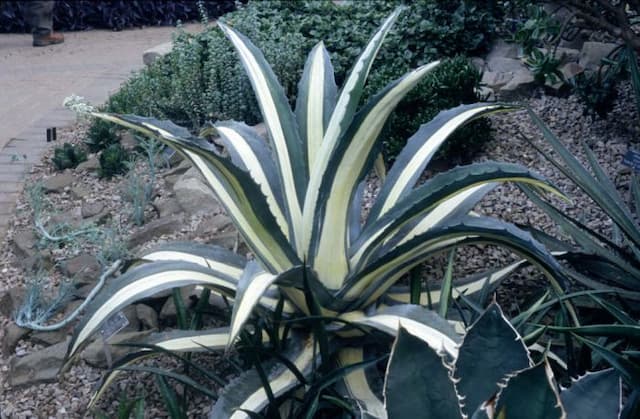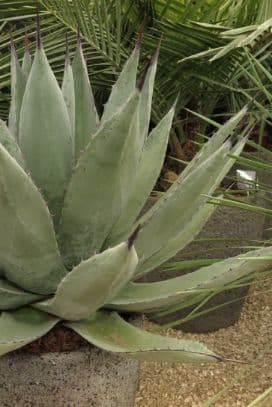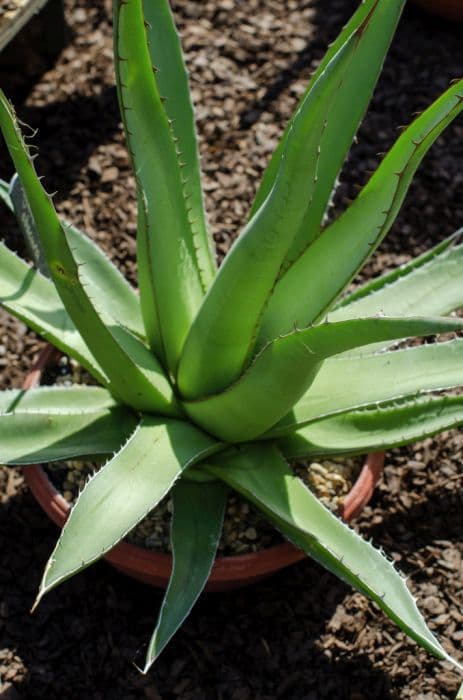Solomon's seal Polygonatum biflorum
ABOUT
Polygonatum biflorum, commonly known as Solomon's seal, is a graceful, perennial plant that is admired for its unique structure and elegant arching stems. The plant's most distinctive feature is its row of hanging, tubular flowers, which are white to pale green and often tipped with green. These small blooms are typically found in pairs below the arches of the stems, lending a delicate and dainty appearance. The leaves of Solomon's seal are simple, alternate, and oval-shaped with pointed tips. They encircle the stem, creating a look of lush fullness with a soft, smooth texture, while their dark green hue provides a rich backdrop for the understated flowers. As the seasons change, some varieties of the plant may exhibit a golden or yellow coloration in the foliage, adding to its autumnal appeal. This woodland native also produces small, spherical berries, which are initially green but turn to a dark blue or black at maturity. The berries stand out against the greenery and provide visual interest after the flowering period has ended. Solomon's seal has an attractive rhizomatous root system, which allows it to spread slowly, forming colonies that can create a beautiful ground cover in shady garden spots. The overall form of the plant is one of graceful arches and subtle charm, making it a favorite for gardeners looking to add a soft, naturalistic feel to their landscapes.
About this plant
 Names
NamesFamily
Asparagaceae
Synonyms
Small Solomon's Seal, Smooth Solomon's Seal, Solomon's Seal, Giant Solomon's Seal, King Solomon's Seal, Two-flowered Solomon's Seal, Sow's Teats, Sealwort, Dropberry
Common names
Convallaria biflora, Polygonatum canaliculatum, Polygonatum commutatum, Polygonatum giganteum, Polygonatum latifolium, Polygonatum oblongifolium, Polygonatum vulgare.
 Toxicity
ToxicityTo humans
Solomon's seal, commonly known as Polygonatum biflorum, is generally not considered highly toxic to humans. However, consuming large quantities of the plant, particularly the berries, can lead to gastrointestinal symptoms such as nausea, diarrhea, and vomiting.
To pets
Solomon's seal is also not highly toxic to pets, but ingestion, especially of the berries, can cause similar gastrointestinal disturbances as in humans, such as vomiting and diarrhea. If a pet consumes a large amount of the plant, it is best to consult a veterinarian.
 Characteristics
CharacteristicsLife cycle
Perennials
Foliage type
Deciduous
Color of leaves
Green
Flower color
White
Height
1-3 feet (0.3-0.9 meters)
Spread
1-2 feet (0.3-0.6 meters)
Plant type
Herb
Hardiness zones
3-8
Native area
North America
Benefits
 General Benefits
General Benefits- Ornamental appeal: Polygonatum biflorum, commonly known as Solomon's seal, adds aesthetic value to gardens with its arching stems and drooping, tubular flowers.
- Shade tolerance: It thrives in shaded woodland areas, making it an excellent choice for garden spots that receive little direct sunlight.
- Drought resistance: Once established, Solomon's seal is relatively drought-tolerant, requiring minimal watering in dry conditions.
- Wildlife attraction: The flowers of Solomon's seal attract pollinators such as bees, while the berries can provide food for birds and other wildlife.
- Natural ground cover: This plant can serve as an effective ground cover, spreading to fill spaces and suppress weeds.
- Seasonal interest: In addition to spring flowers, Solomon's seal produces attractive berries and displays golden-yellow foliage in autumn, offering multiple seasons of interest.
- Low maintenance: Solomon's seal requires little care once established, with no need for regular pruning or fertilization.
- Soil stabilization: With its rhizomatous root system, Solomon's seal can help prevent soil erosion in sloped or uneven garden areas.
 Medical Properties
Medical Properties- Anti-inflammatory: Some compounds in Solomon's seal may have properties that reduce inflammation.
- Immune modulation: The herb has been traditionally used to support the immune system.
- Tonic for the respiratory system: It has been used in folk medicine as a tonic to support the respiratory system.
- Support for the gastrointestinal system: Solomon's seal is sometimes used to aid in digestion and support gastrointestinal health.
- Wound healing: Topically, Solomon's seal root has been used historically to promote the healing of wounds and bruises.
 Air-purifying Qualities
Air-purifying QualitiesThis plant is not specifically known for air purifying qualities.
 Other Uses
Other Uses- Polygonatum biflorum, commonly known as Solomon's seal, can be used as a natural dye, giving a light green color when the leaves are processed.
- The young shoots of Solomon's seal can be prepared and eaten similarly to asparagus in the spring.
- Native Americans once used the roots to make a starchy flour after cooking them thoroughly to break down toxins.
- Due to its arching stems, Solomon's seal is often planted as an ornamental plant for aesthetic appeal in shade gardens.
- The plant's rhizome can be crushed and mixed with water to create a paste for a natural soap substitute.
- Its dried seeds are sometimes used as beads in jewelry making due to their size and hardness.
- The crushed leaves of Solomon's seal can be applied to extinguish small fires as a traditional firefighting method in some cultures.
- The plant's stems are used in traditional basket weaving to create intricate patterns and designs.
- Solomon's seal can act as a companion plant in gardens, reputed to enhance the growth of surrounding plants and vegetables.
- The flowers provide a source of nectar for pollinators like bees during the blooming season, thus contributing to the pollination of gardens and the ecosystem.
Interesting Facts
 Feng Shui
Feng ShuiSolomon's seal is not used in Feng Shui practice.
 Zodiac Sign Compitability
Zodiac Sign CompitabilitySolomon's seal is not used in astrology practice.
 Plant Symbolism
Plant Symbolism- Healing - Polygonatum biflorum, commonly known as Solomon's Seal, is often associated with healing properties due to its medicinal uses in traditional practices for various ailments.
- Protection - The seal-like scars on the rootstock resemble the Hebrew king's seal, suggesting that the plant offers protection and wards off evil, similar to the protective qualities attributed to King Solomon.
- Wisdom - Reflecting the wisdom of Solomon, this plant symbolizes the search for knowledge and wisdom in the natural world.
- Elegance - The arching stems and simple, bell-shaped flowers of Solomon's Seal represent grace and understated beauty.
 Water
WaterSolomon's seal prefers evenly moist soil, especially during the growing season. Water it once a week with about an inch of water, equivalent to approximately 0.6 gallons per square foot of soil area. During dry spells, it may require additional water to maintain moisture levels. In the fall, as the plant goes dormant, reduce watering frequency. Ensure the plant is watered deeply which encourages root growth rather than shallow waterings.
 Light
LightSolomon's seal thrives in partial to full shade. The ideal spot for this plant is under a canopy of trees or in a shaded garden bed where it can receive filtered sunlight. Direct afternoon sun can be too harsh and lead to foliage burn, so avoid placing it in a location where it would be exposed to intense light for extended periods.
 Temperature
TemperatureSolomon's seal does well in a temperature range between 60°F and 70°F but can tolerate temperatures down to 5°F and up to 85°F. While it prefers cooler conditions, it will survive in hotter temperatures if it's kept in shade and the soil remains moist. Ensure protection from extreme cold by providing a layer of mulch during winter to prevent the ground from freezing.
 Pruning
PruningSolomon's seal requires minimal pruning. Remove dead or yellowing leaves, and, after the foliage dies back in late fall, cut back the stems to ground level. This will keep the plant tidy and help prevent disease. Pruning is typically only necessary once a year, and the best time is right after the plant goes dormant in the fall.
 Cleaning
CleaningAs needed
 Soil
SoilSolomon's Seal prefers well-draining, rich in organic matter soil with a pH between 5.5 and 7. A good mix can be made of equal parts garden soil, peat moss, and perlite to ensure moisture retention and drainage.
 Repotting
RepottingSolomon's Seal does not require frequent repotting and can often be left undisturbed for several years. It may be repotted every 3 to 5 years to refresh the soil and divide clumps if necessary.
 Humidity & Misting
Humidity & MistingSolomon's Seal thrives in average to high humidity levels, generally preferring around 40% to 60%. They do not require overly moist air but appreciate not being in excessively dry conditions.
 Suitable locations
Suitable locationsIndoor
Place Solomon's Seal in bright, indirect light; keep soil moist, not soggy.
Outdoor
Plant Solomon's Seal in shaded area with moist, well-draining soil.
Hardiness zone
3-8 USDA
 Life cycle
Life cyclePolygonatum biflorum, commonly known as Solomon's Seal, begins its life cycle as a rhizome, which is an underground stem capable of producing the roots and shoots necessary for growth. In spring, the rhizome gives rise to stems that uncoil upwards, bearing leaves and flowers; the plant enters its vegetative stage, with leaves photosynthesizing to provide energy for growth. The flowers then develop, typically in April or May, hanging in pairs from the leaf axils and providing opportunities for pollination by insects. Following pollination, the flowers develop into berries by late summer, which turn a dark blue-black at maturity and contain seeds. These seeds are subsequently dispersed by wildlife, especially birds, allowing for the potential colonization of new areas. In winter, the above-ground foliage dies back, and the plant enters a period of dormancy until the cycle begins anew come the next spring.
 Propogation
PropogationPropogation time
Spring to early summer
The most popular method of propagation for Solomon's seal (Polygonatum biflorum) involves the division of its rhizomes. This process is typically carried out in the fall, after the leaves have died back, or in early spring before growth resumes. To propagate by division, gardeners should carefully dig around the plant and gently lift the clump of rhizomes from the ground. Using a sharp knife, the clump is then divided into smaller sections, each with at least one growing point or "eye." These divisions are then replanted in prepared soil, spaced approximately a foot apart to allow ample room for growth. It's important to plant the divisions at the same depth they were growing previously to encourage successful establishment.









